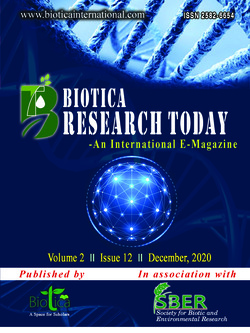
Loose Smut of Wheat Caused by Ustilago tritici and Its Management
Ramniwas Yadav*
Division of Plant Pathology, Rajasthan Agricultural Research Institute (RARI), Durgapura, Jaipur, Rajasthan (302 018), India
Anupriya
Division of Plant Pathology, Rajasthan Agricultural Research Institute (RARI), Durgapura, Jaipur, Rajasthan (302 018), India
P.S. Shekhawat
Division of Plant Pathology, Rajasthan Agricultural Research Institute (RARI), Durgapura, Jaipur, Rajasthan (302 018), India
DOI: NIL
Keywords: Loose smut, Seed-borne disease, Ustilago tritici, Wheat
Abstract
Among all diseases of wheat, seed-borne disease such as smut is found in every area where the wheat is grown. Loose smut of wheat is occurred in cool and moist climate conditions. The successful infection of loose smut can occur after the anthesis. The pathogen remains dormant in the mature seed and germinates with germinating seeds. The mycelium of the fungus grows in the crown node and finally invades the inflorescence tissues. It develops with the seed embryo. It is disseminated by infected seeds and air by short distance. Most of the inoculums sources of loose smut are infected wheat seeds and air borne teliospores from smutted heads. In every infected areas of wheat by loose smut, a new race may arise by recombination of pre-existing virulence genes or through mutations. So, different types of management systems such as using of certified seeds treated with protectant fungicides, planting of resistant cultivars is very important.
Downloads
not found
Reference
Mitra, M., Taslim, M., 1936. The control of loose smut of wheat in North Bihar by the solar energy and sun-heated water methods. Agr. and Live-Stock 6, 43-47.
Clark, B., Cockerill, V., 2011. Research Review No. 75: European Case Study on Seed Treatments and Seed-borne Disease Control Using Seed Treatments. Agriculture and Horticulture Development Board (AHDB), p. 36.
Luthra, J.C., 1941. Solar treatment of wheat loose smut. Indian Fing 2, 416-418.
